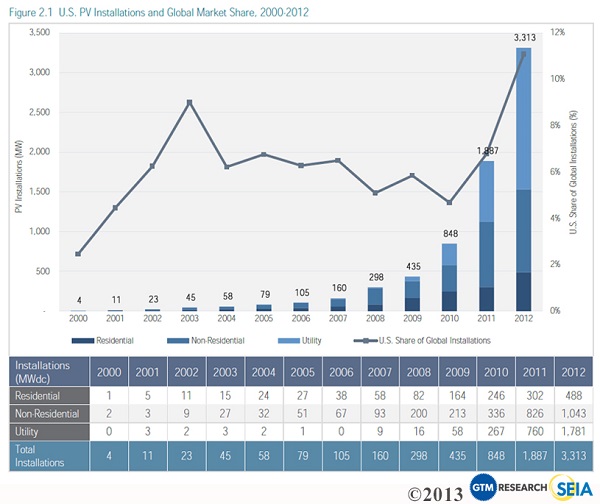Sorry, wind; the solar sector was the true energy star of 2012. It gets that title after installing 3,313 megawatts of new capacity – a 76 percent increase over 2011’s 1,887 MW, according to industry data released today.
Yeah, wind had a much heftier 2012 total, at a little more than 13,000 MW, but it started from a bigger base and its gaudy number was a one-time thing, driven by the feared expiration of a key tax credit. Solar earned its growth naturally, luring new customers with lower prices and increasingly popular leasing options, and bringing a number of giant utility-scale plants online after years of planning and development.

Solar came into 2013 with a head of steam, and appears ready to roll on. Some 1,300 MW of capacity were added in the final quarter of the year and GTM Research and the Solar Energy Industries Association, who compiled the data, forecast that this year will bring at least 5,200 MW of additional capacity (4,300 MW of PV, and 946 MW of concentrating solar). That’ll be a slower annual growth rate, but would take U.S. solar well over the 10 gigawatt mark, a level only Germany and Italy have so far attained.
“There were 16 million solar panels installed in the U.S. last year – more than 2 panels per second of the work day – and every one of these panels was bolted down by a member of the U.S. workforce,” Rhone Resch, president and CEO of SEIA, said in a statement. “We’ve brought more new solar online in 2012 than in the three prior years combined.”
Residential was the smallest part of the 2012 pie, with 488 MW (compared to 1,043 MW in commercial installations and 1,782 MW on the utility-scale side), but that was still a record – one that’s not likely to stand for long, not with solar becoming ever more afforadable. Despite duties on Chinese solar imports, the installed cost of solar fell from $6.16 per watt in Q4 2011 to $5.04 per watt in Q4 2012, the report said.
“All of these data point to solar having turned the corner,” Resch said. “Solar is an affordable option for homes and businesses today, and is well on its way to becoming a substantial part of America’s energy portfolio.”
It’s growing fast, no doubt; but it needs to continue on that aggressive pace in order to fulfill Resch’s prophecy (and catch up to those solar-crazy Germans, not to mention Greece, which kicks U.S. butt on a per capita basis). Our estimate, based on government data and forecasts, is that solar in 2012 generated around 11,102 gigawatt-hours of electricity in the U.S. in 2012, out of 4,054,485 GWh from all sources. That puts solar’s portion at 0.27 percent.
Some other highlights, quoted from the report:
- there are now more than 300,000 PV systems operating across the U.S.;
- the U.S. installed 11% of all global PV in 2012, the highest market share in at least fifteen years;
- cumulative PV capacity operating in the U.S. as of the end of 2012 stood at 7,221 MW and cumulative operating concentrating solar stood at 546 MW;
- twelve states installed over 50 MW of solar each in 2012, up from eight in 2011;
- there were over 90,000 solar installations in 2012, including 83,000 in the residential market alone;
- and the non-residential segment, which includes commercial, governmental, and non-profit systems, installed more than 1,000 MW in 2012 (leading non-residential markets included California, New Jersey, Arizona, Massachusetts, and Hawaii).